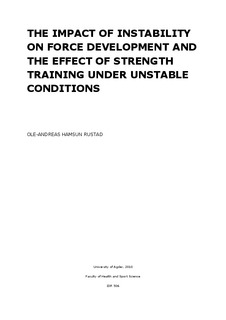| dc.description.abstract | Objective: The efficacy of maximal strength training on unstable surfaces remains unclear.
The aims of this study were therefore to 1) quantify maximal dynamic force during a push-up
movement with and without instability, 2) investigate whether training under unstable
conditions would decrease the deficit between unstable and stable maximal force and 3)
compare strength adaptations in the shoulder complex between traditional strength training
and unstable strength training.
Methods: 29 physically active university students (23 males, 6 females) performed maximal
dynamic force tests under stable (explosive push-up on force platform, MDFstable) and
unilaterally unstable (explosive push-up in instrumented slings, MDFunstable) as well as
stable (PUstable) and unstable (PUunstable) push-up to failure tests and 1RM bench press. 19
of the subject were randomized to an unstable training group or a stable training group. The
remaining 10 was recruited as non-training controls. The two training groups trained 2 days a
week for 8 weeks using identical periodization of sets and repetitions. Testing was repeated
after 8 weeks.
Results: For all subjects, MDFunstable was 26 ±15% lower than MDFstable during
preliminary testing (MDFunstable/MDFstable, ratio = 0.75±0.21). Training under unstable
conditions did not decrease the deficit between MDFunstable and MDFstable because both
improved similarly, but a significant decrease in deficit between PUunstable and PUstable
was observed (pre: PUunstable = 51±17% of MDFstable, post: PUunstable = 78±16% of
MDFstable, p ≤ 0.01). Both stable and unstable training induced similar improvement in
MDFstable (unstable: 25±20%, stable: 27±21%), 1 RM bench press (unstable: 10±7%, stable:
13±6%) and PUstable (unstable: 27±26%, stable: 30±31%). However, the unstable training
group increased significantly more than the stable group in MDFunstable and PUunstable (p ≤
0.05).
Conclusion: Unilateral instability directly applied to the shoulder complex results in
substantial (~25%), but individually variable loss of maximal dynamic force during a
dynamic, maximally explosive push-up movement. Strength training under unstable
conditions did not reduce the deficit in force development between stable and unstable
conditions. Strength training in unilaterally unstable slings stimulates large improvements in
strength and maximal dynamic force development under both unstable and stable conditions,
while stable strength training improvements is more limited to stable conditions. | en_US |
